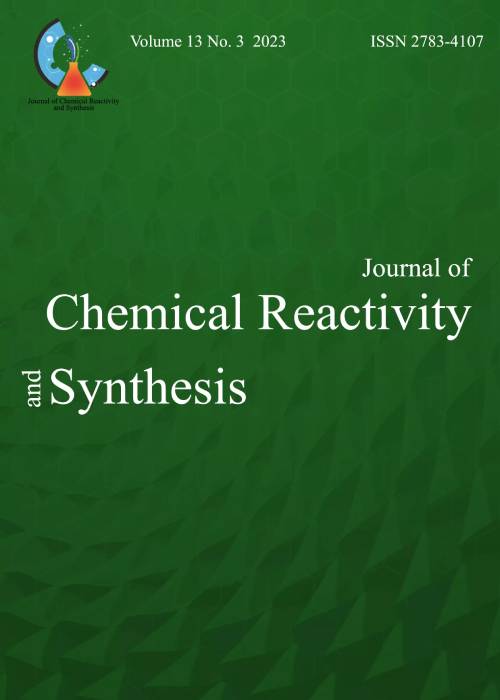فهرست مطالب
Journal of Chemical Reactivity and Synthesis
Volume:9 Issue: 4, Autumn 2019
- تاریخ انتشار: 1397/08/22
- تعداد عناوین: 6
-
Pages 1-6
The present paper aims to suggest a simple/fast route for direct preparation of the Ni-doped ZnSe/ZnS core/shell NCs in aqueous solution. Using XRD measurement, the zinc blend structure and sub-5 nm average size of the NCs was proved. The FT-IR spectrum also showed the passivation of the NCs surface by means of the deprotonated thiol terminals of the NAC molecules. The intensity of the dopant-related emission at about 476 nm in Ni:ZnSe doped NCs was found to experience more than four times enhancement by utilization of the extra ZnS shell. It was also observed that the increasing of the shell overcoating time from 1 to 3 h, has effective role on better passivation of the surface of the NCs and increasing of the emission intensity
Keywords: Colloidal synthesis, Ni-doped ZnSe NCs, Core, shell structures, Photoluminescence emission -
Pages 7-12
Polyethersulfone (PES)-based on mixed matrix nanofiltration membrane was developed by amalgamation with partially reduced acetone nanocomposite. The effect of acetone fillings on the morphology and performance of the prepared membranes was examined by scanning electron microscopy (SEM) and water contact angle analysis. The blended membranes showed improved water permeability and fouling resistance likened to the simple PES. When the content of acetone was 100 wt.%, the water flux touched a maximum value (10.5 kg/m2 h) nearly twice of that of the simple PES membrane (3.5 kg/m2 h). Fouling confrontation of the membranes studied by stupid serum albumin solution filtration presented that 10 wt.% acetone membrane had the best antifouling property. Nanofiltration performance of the prepared membranes was assessed by rejection of three organic dyes with different molecular masses.
Keywords: Nanofiltration, Acetone, Antifouling, Dye separation, Mixed membrane -
Pages 13-20
One of the new separation methods for purifying biodiesel used in recent years is the membrane separation process. In the current research, purification of produced biodiesel was carried out using Polymeric Poly Ether Sulfone(PES) based membrane. The prepared PVP membranes was containing 1, 1.5, 2 and 3 wt.% of PVP concentration with 16 wt.% PES. as additive. Reported experimental determining the membrane flux and separation efficiency (glycerol rejection) membrane was modeled by Maxwell Model. The result, including penetration rate, theory graph and experimental data comparison for biodiesel and glycerin, and error graphs have been explained. Results showed that the experimental data’s have Compatibility with the model and, membrane with 2 percent PVP has provided more acceptable results.
Keywords: Mathematic model, Maxwell model, Biodiesel, PES, PVP -
Pages 21-24
In this research, we investigate the interaction of HCN gas with SiCNTs to making new absorber and sensor for HCN gas. All stable adsorption structures are individually optimized by using density function theory at the cam-B3LYP level of theory using the Gaussian 09 set of programs. From optimized structures the DOS plots, MEP plot and quantum molecular descriptors: gap energy, chemical potential (μ), global hardness (η), electrophilicity index (ω), and electronegativity (χ) of the nanotubes are calculated. The results indicate that the adsorption of HCN from N and H head in the vertical direction of surface of SiCNTs is favorable than other those models in thermodynamically approach. The quantum parameters demonstrate that the SiCNTs is a good candidate for detecting HCN gas.
Keywords: SiCNTs, DFT, HCN interaction, quantum parameters -
Pages 25-31
Hydrogen sulfide is a flammable, malodorous, highly toxic and corrosive compound which is produced in large quantities as a by-product in many industrial processes. However, it will be economically and environmentally advantageous if it is photodecomposed to generate hydrogen, which is a clean and renewable energy carrier. In this paper, a nanostructured solid-solution semiconductor material from the family of cadmium-zinc-sulfide was synthesized through a facile hydrothermal method and was applied as alloy photocatalyst to generate hydrogen fuel via a H2S photodecomposition process. Morphological and optical properties of the sample have been characterized by XRD, FE-SEM, EDS and UV-vis DRS techniques. Solid-solution semiconductor exhibited a good photocatalytic performance.
Keywords: Solar hydrogen generation, Photocatalyst, H2S photodecomposition, solid-solution semiconductor -
Pages 32-38
A two-dimensional mathematical model was studied for the transport of CO2 and H2S through hollow fiber membrane (HFM) contactors while using MEA (monoethanolamine) as the chemical absorber. The model considered non-wetted where the gas and the solvent liquid fill the membrane pores for counter current gas–liquid flow direction. There is an axial and radial diffusion in the tube, through the membrane and the shell. The model validation was on the physical and chemical absorption of CO2 using water and MEA, respectively. The percentage of removal of CO2 increased while increasing the absorbent velocity. As for H2S, low flow rate of amine was efficient in complete removal. The percentage removal of CO2 decreased while increasing gas velocity because of lower hold up time, whereas H2S removal did not change with increasing gas velocity at low gas velocities. However the effect is more obvious at high gas velocities.
Keywords: CO2, Natural gas, H2S, MEA


